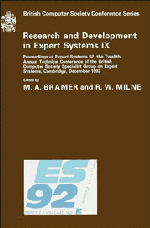Book contents
- Frontmatter
- Contents
- Preface
- Introduction
- CONSULTANT: providing advice for the machine learning toolbox
- A methods model for the integration of KBS and conventional information technology
- KBS methodology as a framework for co-operative working
- Project management for the evolutionary development of expert systems
- The specification and development of rule-based expert systems
- Towards a method for multi-agent system design
- Jigsaw: configuring knowledge acquisition tools
- On the relationship between repertory grid and term subsumption knowledge structures: theory practice tools
- Strategy maze: an on-line tool for support management of the knowledge acquisition process
- Concurrent engineering using collaborating truth maintenance systems
- Ockham's razor as a gardening tool
- A designer's consultant
- Fairness of attribute selection in probabilistic induction
- An application of case-based expert system technology to dynamic job-shop scheduling
- Neural network design via LP
- KEshell2: an intelligent learning data base system
- Approaches to self-explanation and system visibility in the context of application tasks
- An object oriented approach to distributed problem solving
- Intelligent user interface for multiple application systems
- Combining qualitative and quantitative information for temporal reasoning
- Documents as expert systems
A methods model for the integration of KBS and conventional information technology
Published online by Cambridge University Press: 04 August 2010
- Frontmatter
- Contents
- Preface
- Introduction
- CONSULTANT: providing advice for the machine learning toolbox
- A methods model for the integration of KBS and conventional information technology
- KBS methodology as a framework for co-operative working
- Project management for the evolutionary development of expert systems
- The specification and development of rule-based expert systems
- Towards a method for multi-agent system design
- Jigsaw: configuring knowledge acquisition tools
- On the relationship between repertory grid and term subsumption knowledge structures: theory practice tools
- Strategy maze: an on-line tool for support management of the knowledge acquisition process
- Concurrent engineering using collaborating truth maintenance systems
- Ockham's razor as a gardening tool
- A designer's consultant
- Fairness of attribute selection in probabilistic induction
- An application of case-based expert system technology to dynamic job-shop scheduling
- Neural network design via LP
- KEshell2: an intelligent learning data base system
- Approaches to self-explanation and system visibility in the context of application tasks
- An object oriented approach to distributed problem solving
- Intelligent user interface for multiple application systems
- Combining qualitative and quantitative information for temporal reasoning
- Documents as expert systems
Summary
INTRODUCTION
The last few years has seen a significant change in commercial KBS development. Organisations are now building KBS to solve specific business problems rather than simply to see what the technology can do. There has also been a move away from building KBS on stand alone PCs to using the corporate resources of networks, mini and Mainframe computers, and existing databases. As a result of these changes, two significant questions are now being regularly asked by organisations developing or interested in developing KBS:
How can KBS be linked into existing systems to enhance their processing functions and make better use of data already held?
What methods can be used to help build commercial applications using KBS techniques?
The key to these questions is the use of an integrated approach to the development of all IT systems. There are many methods available for conventional systems development, such as Information Engineering, SSADM, Jackson and Yourdon. There are also a number of KBS methods available or under development such as KADS, KEATS, and GEMINI. However, commercial organisations with well established procedures for conventional development do not want to use two different methods side-by-side, nor do they wish to discard their current conventional development method and replace it with a method claiming to cover all aspects of conventional and KBS development. Organisations therefore require some way of integrating KBS methods into their existing methods.
- Type
- Chapter
- Information
- Research and Development in Expert Systems IX , pp. 25 - 44Publisher: Cambridge University PressPrint publication year: 1993
- 1
- Cited by



